Autumn 2016-17: Employee Engagement Report for NHS Trust, BUS020N582S
VerifiedAdded on 2020/01/23
|14
|4474
|86
Report
AI Summary
This report examines employee engagement challenges within an NHS Trust, focusing on issues like employee motivation, communication, and leadership. The report begins with an executive summary highlighting the importance of employee engagement in modern businesses and its impact on company performance. It identifies problems such as lack of challenging job roles, monotonous tasks, inadequate employee involvement in decision-making, and insufficient safety measures, leading to decreased motivation, reduced productivity, and poor service quality. The report proposes solutions including change management processes, improved employee interaction through brainstorming sessions and reward programs, enhanced communication channels, and fostering trust through strong leadership. The report also includes a personal development plan for self-assessment of skills and techniques. The report emphasizes the significance of addressing employee relations issues to improve the overall performance and reputation of the NHS Trust as a healthcare provider. The report is based on the BUS020N582S module on Understanding Employee Relations.
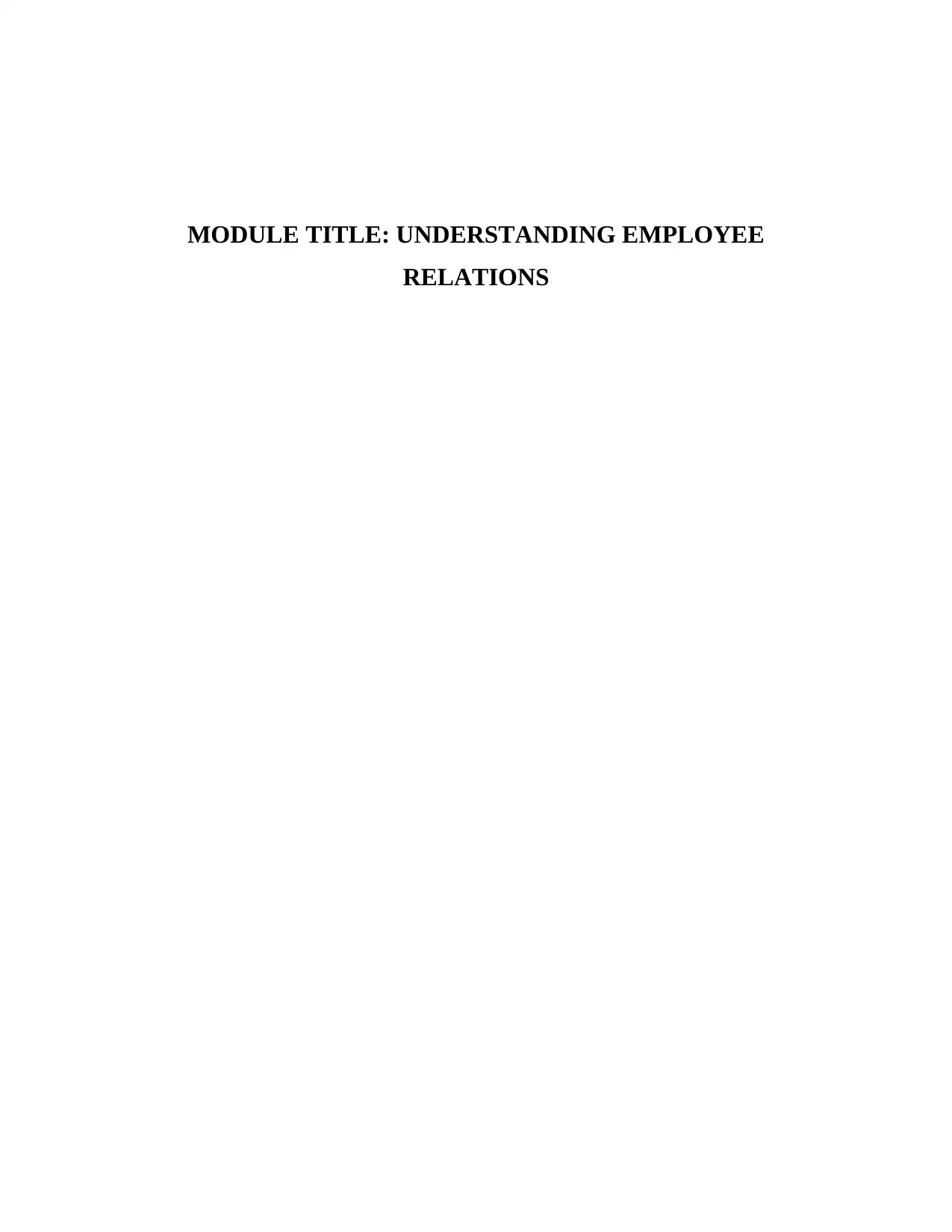
MODULE TITLE: UNDERSTANDING EMPLOYEE
RELATIONS
RELATIONS
Paraphrase This Document
Need a fresh take? Get an instant paraphrase of this document with our AI Paraphraser
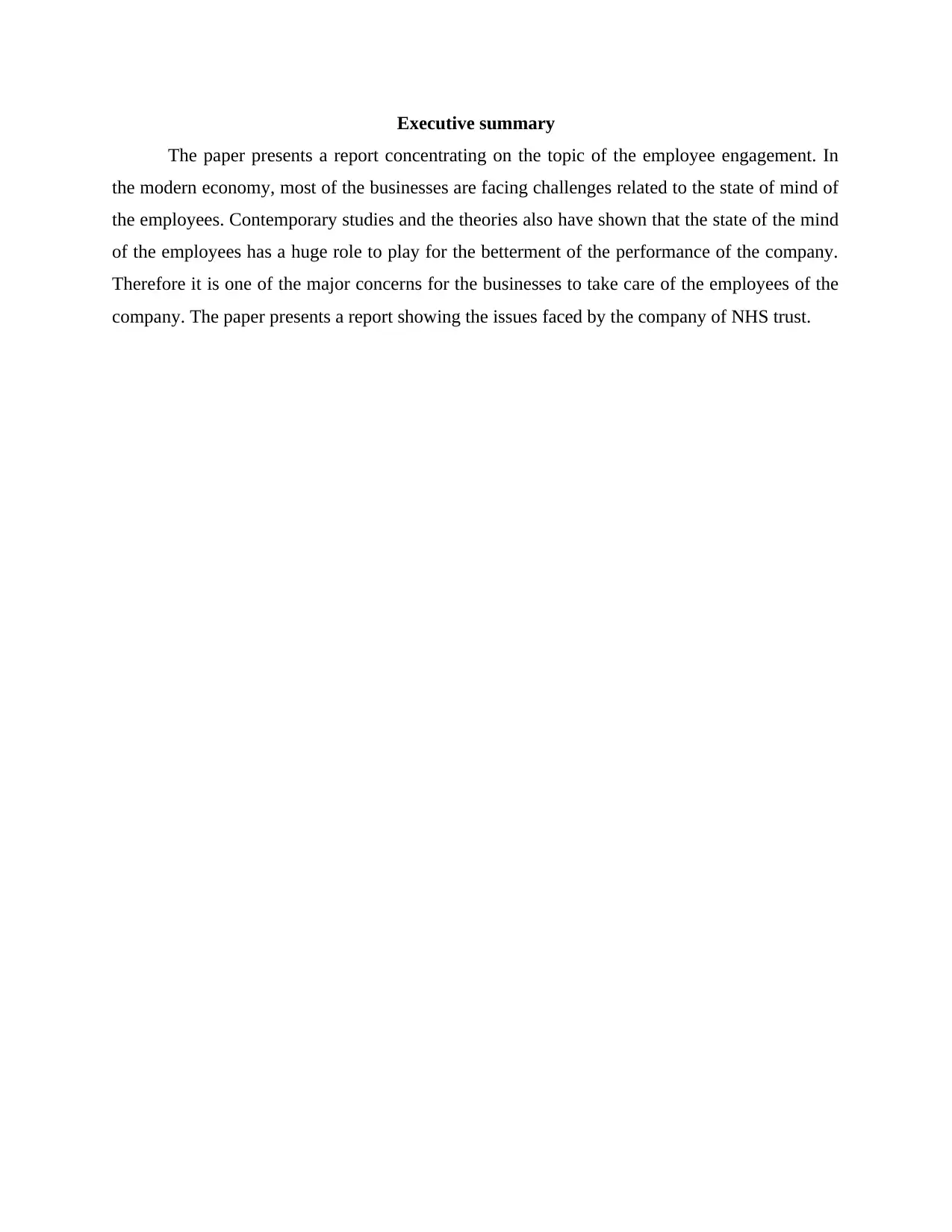
Executive summary
The paper presents a report concentrating on the topic of the employee engagement. In
the modern economy, most of the businesses are facing challenges related to the state of mind of
the employees. Contemporary studies and the theories also have shown that the state of the mind
of the employees has a huge role to play for the betterment of the performance of the company.
Therefore it is one of the major concerns for the businesses to take care of the employees of the
company. The paper presents a report showing the issues faced by the company of NHS trust.
The paper presents a report concentrating on the topic of the employee engagement. In
the modern economy, most of the businesses are facing challenges related to the state of mind of
the employees. Contemporary studies and the theories also have shown that the state of the mind
of the employees has a huge role to play for the betterment of the performance of the company.
Therefore it is one of the major concerns for the businesses to take care of the employees of the
company. The paper presents a report showing the issues faced by the company of NHS trust.
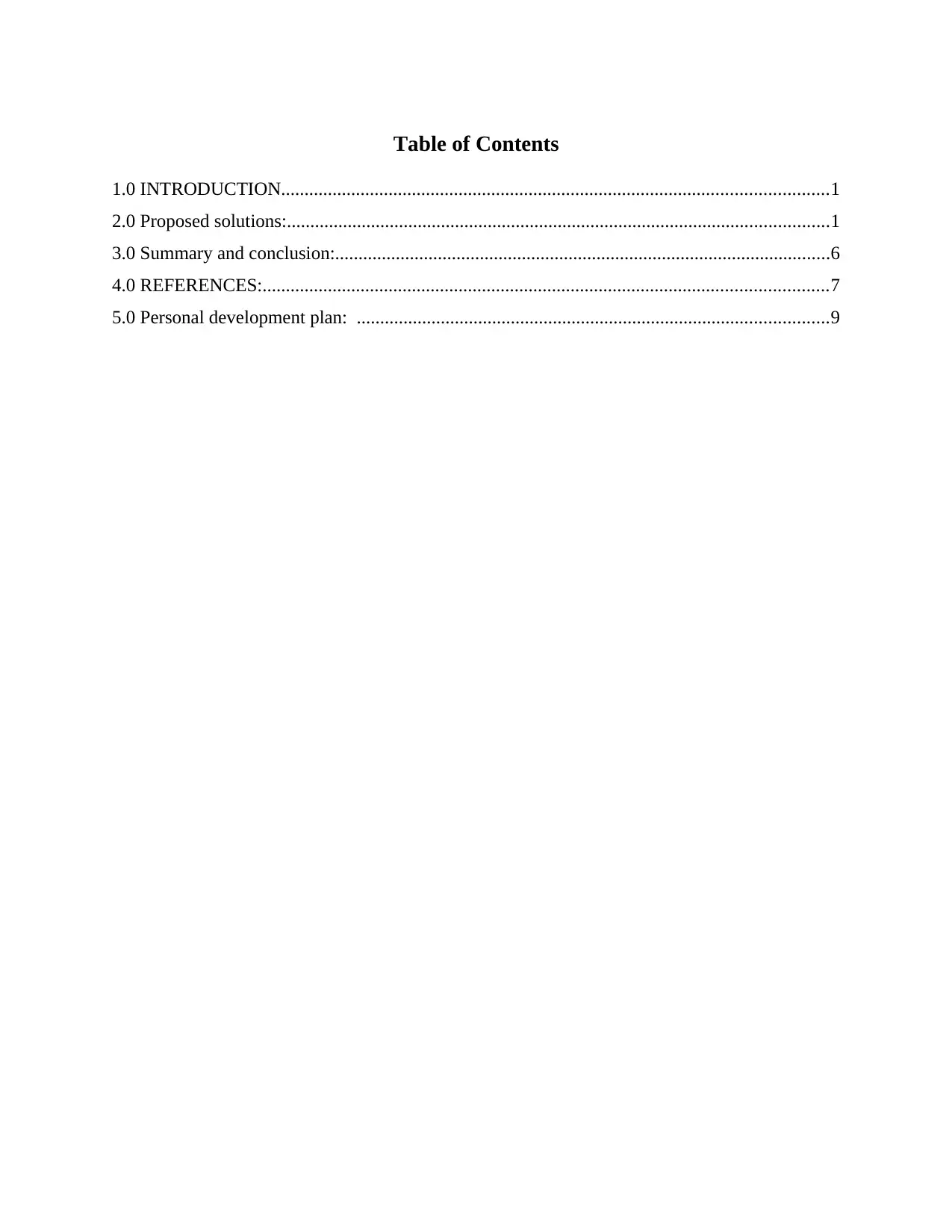
Table of Contents
1.0 INTRODUCTION.....................................................................................................................1
2.0 Proposed solutions:....................................................................................................................1
3.0 Summary and conclusion:..........................................................................................................6
4.0 REFERENCES:.........................................................................................................................7
5.0 Personal development plan: .....................................................................................................9
1.0 INTRODUCTION.....................................................................................................................1
2.0 Proposed solutions:....................................................................................................................1
3.0 Summary and conclusion:..........................................................................................................6
4.0 REFERENCES:.........................................................................................................................7
5.0 Personal development plan: .....................................................................................................9
⊘ This is a preview!⊘
Do you want full access?
Subscribe today to unlock all pages.

Trusted by 1+ million students worldwide
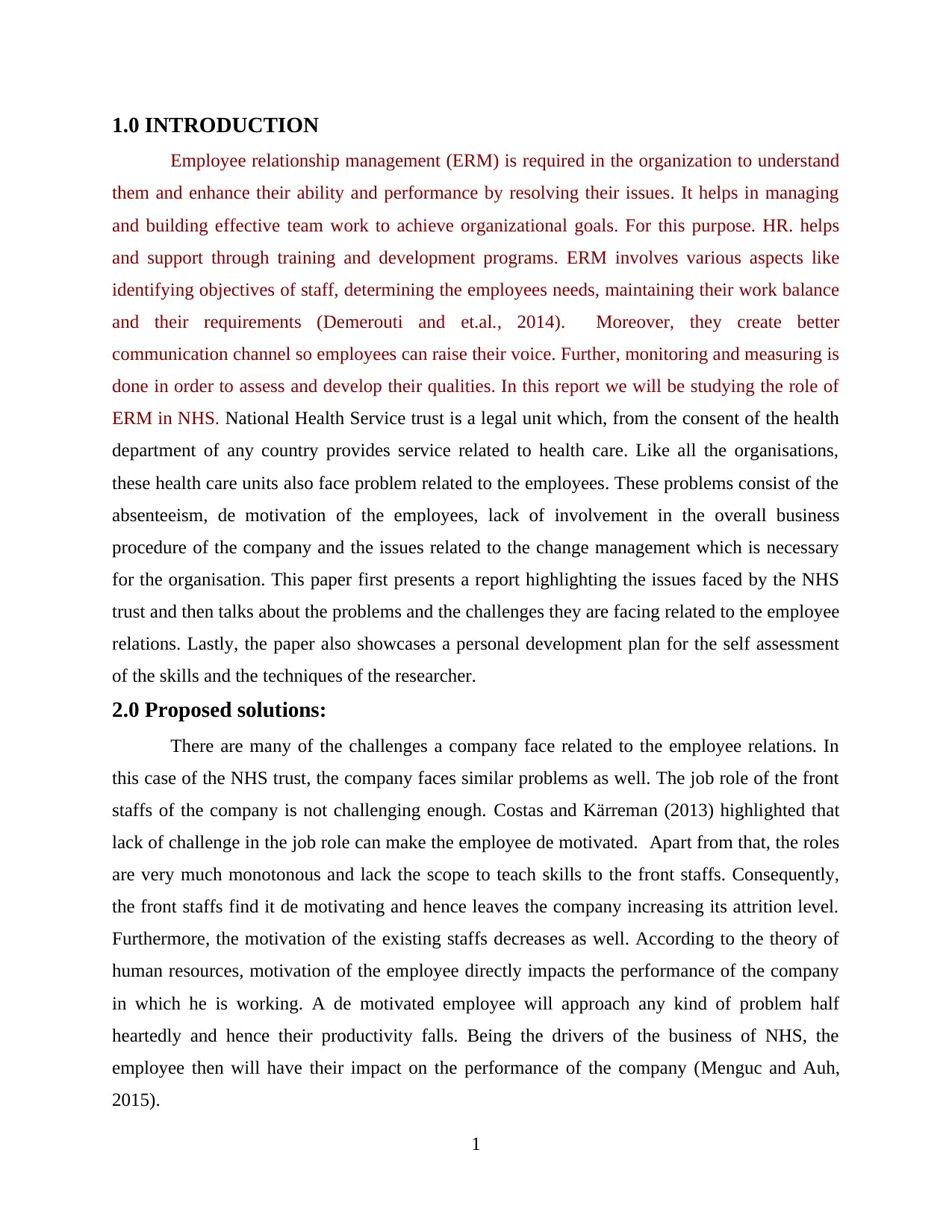
1.0 INTRODUCTION
Employee relationship management (ERM) is required in the organization to understand
them and enhance their ability and performance by resolving their issues. It helps in managing
and building effective team work to achieve organizational goals. For this purpose. HR. helps
and support through training and development programs. ERM involves various aspects like
identifying objectives of staff, determining the employees needs, maintaining their work balance
and their requirements (Demerouti and et.al., 2014). Moreover, they create better
communication channel so employees can raise their voice. Further, monitoring and measuring is
done in order to assess and develop their qualities. In this report we will be studying the role of
ERM in NHS. National Health Service trust is a legal unit which, from the consent of the health
department of any country provides service related to health care. Like all the organisations,
these health care units also face problem related to the employees. These problems consist of the
absenteeism, de motivation of the employees, lack of involvement in the overall business
procedure of the company and the issues related to the change management which is necessary
for the organisation. This paper first presents a report highlighting the issues faced by the NHS
trust and then talks about the problems and the challenges they are facing related to the employee
relations. Lastly, the paper also showcases a personal development plan for the self assessment
of the skills and the techniques of the researcher.
2.0 Proposed solutions:
There are many of the challenges a company face related to the employee relations. In
this case of the NHS trust, the company faces similar problems as well. The job role of the front
staffs of the company is not challenging enough. Costas and Kärreman (2013) highlighted that
lack of challenge in the job role can make the employee de motivated. Apart from that, the roles
are very much monotonous and lack the scope to teach skills to the front staffs. Consequently,
the front staffs find it de motivating and hence leaves the company increasing its attrition level.
Furthermore, the motivation of the existing staffs decreases as well. According to the theory of
human resources, motivation of the employee directly impacts the performance of the company
in which he is working. A de motivated employee will approach any kind of problem half
heartedly and hence their productivity falls. Being the drivers of the business of NHS, the
employee then will have their impact on the performance of the company (Menguc and Auh,
2015).
1
Employee relationship management (ERM) is required in the organization to understand
them and enhance their ability and performance by resolving their issues. It helps in managing
and building effective team work to achieve organizational goals. For this purpose. HR. helps
and support through training and development programs. ERM involves various aspects like
identifying objectives of staff, determining the employees needs, maintaining their work balance
and their requirements (Demerouti and et.al., 2014). Moreover, they create better
communication channel so employees can raise their voice. Further, monitoring and measuring is
done in order to assess and develop their qualities. In this report we will be studying the role of
ERM in NHS. National Health Service trust is a legal unit which, from the consent of the health
department of any country provides service related to health care. Like all the organisations,
these health care units also face problem related to the employees. These problems consist of the
absenteeism, de motivation of the employees, lack of involvement in the overall business
procedure of the company and the issues related to the change management which is necessary
for the organisation. This paper first presents a report highlighting the issues faced by the NHS
trust and then talks about the problems and the challenges they are facing related to the employee
relations. Lastly, the paper also showcases a personal development plan for the self assessment
of the skills and the techniques of the researcher.
2.0 Proposed solutions:
There are many of the challenges a company face related to the employee relations. In
this case of the NHS trust, the company faces similar problems as well. The job role of the front
staffs of the company is not challenging enough. Costas and Kärreman (2013) highlighted that
lack of challenge in the job role can make the employee de motivated. Apart from that, the roles
are very much monotonous and lack the scope to teach skills to the front staffs. Consequently,
the front staffs find it de motivating and hence leaves the company increasing its attrition level.
Furthermore, the motivation of the existing staffs decreases as well. According to the theory of
human resources, motivation of the employee directly impacts the performance of the company
in which he is working. A de motivated employee will approach any kind of problem half
heartedly and hence their productivity falls. Being the drivers of the business of NHS, the
employee then will have their impact on the performance of the company (Menguc and Auh,
2015).
1
Paraphrase This Document
Need a fresh take? Get an instant paraphrase of this document with our AI Paraphraser
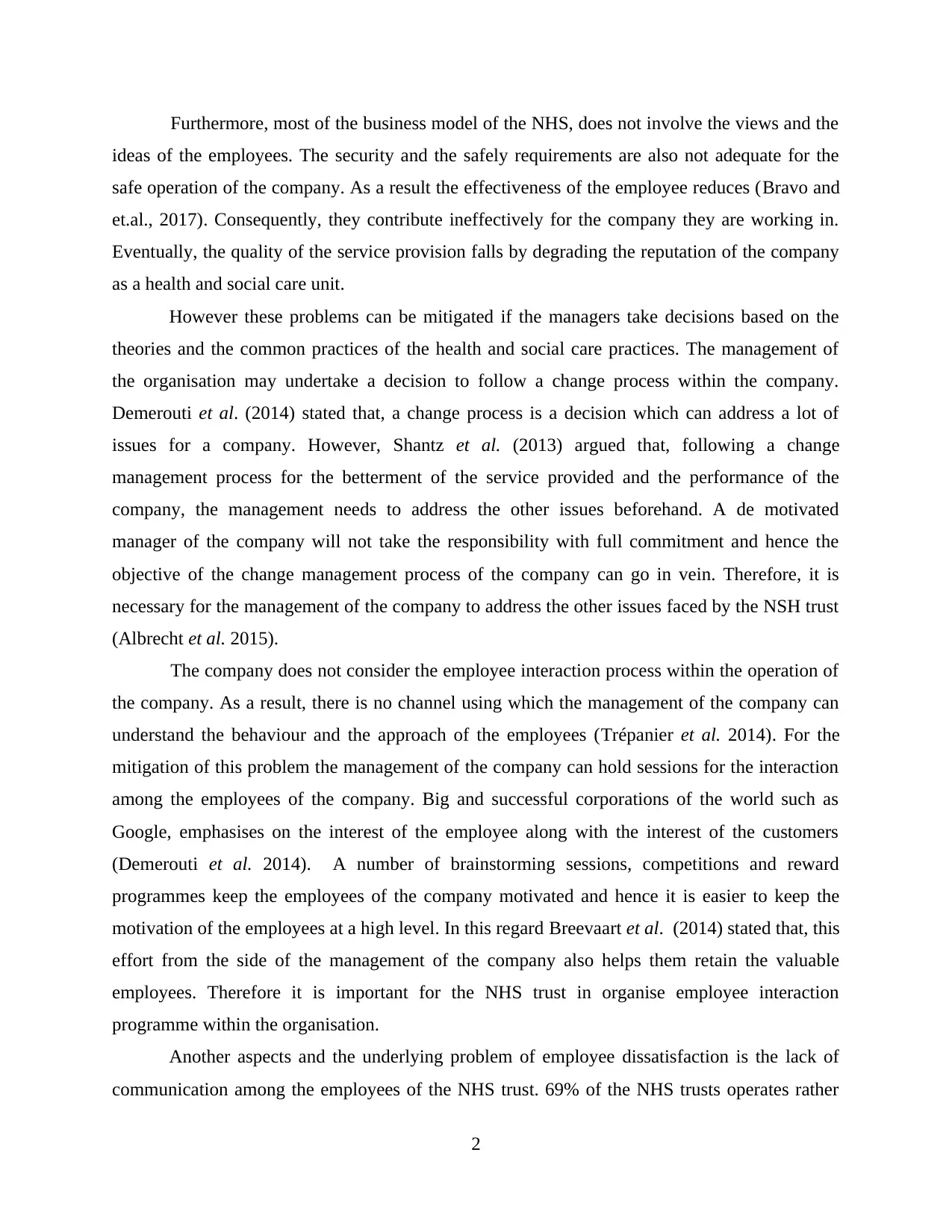
Furthermore, most of the business model of the NHS, does not involve the views and the
ideas of the employees. The security and the safely requirements are also not adequate for the
safe operation of the company. As a result the effectiveness of the employee reduces (Bravo and
et.al., 2017). Consequently, they contribute ineffectively for the company they are working in.
Eventually, the quality of the service provision falls by degrading the reputation of the company
as a health and social care unit.
However these problems can be mitigated if the managers take decisions based on the
theories and the common practices of the health and social care practices. The management of
the organisation may undertake a decision to follow a change process within the company.
Demerouti et al. (2014) stated that, a change process is a decision which can address a lot of
issues for a company. However, Shantz et al. (2013) argued that, following a change
management process for the betterment of the service provided and the performance of the
company, the management needs to address the other issues beforehand. A de motivated
manager of the company will not take the responsibility with full commitment and hence the
objective of the change management process of the company can go in vein. Therefore, it is
necessary for the management of the company to address the other issues faced by the NSH trust
(Albrecht et al. 2015).
The company does not consider the employee interaction process within the operation of
the company. As a result, there is no channel using which the management of the company can
understand the behaviour and the approach of the employees (Trépanier et al. 2014). For the
mitigation of this problem the management of the company can hold sessions for the interaction
among the employees of the company. Big and successful corporations of the world such as
Google, emphasises on the interest of the employee along with the interest of the customers
(Demerouti et al. 2014). A number of brainstorming sessions, competitions and reward
programmes keep the employees of the company motivated and hence it is easier to keep the
motivation of the employees at a high level. In this regard Breevaart et al. (2014) stated that, this
effort from the side of the management of the company also helps them retain the valuable
employees. Therefore it is important for the NHS trust in organise employee interaction
programme within the organisation.
Another aspects and the underlying problem of employee dissatisfaction is the lack of
communication among the employees of the NHS trust. 69% of the NHS trusts operates rather
2
ideas of the employees. The security and the safely requirements are also not adequate for the
safe operation of the company. As a result the effectiveness of the employee reduces (Bravo and
et.al., 2017). Consequently, they contribute ineffectively for the company they are working in.
Eventually, the quality of the service provision falls by degrading the reputation of the company
as a health and social care unit.
However these problems can be mitigated if the managers take decisions based on the
theories and the common practices of the health and social care practices. The management of
the organisation may undertake a decision to follow a change process within the company.
Demerouti et al. (2014) stated that, a change process is a decision which can address a lot of
issues for a company. However, Shantz et al. (2013) argued that, following a change
management process for the betterment of the service provided and the performance of the
company, the management needs to address the other issues beforehand. A de motivated
manager of the company will not take the responsibility with full commitment and hence the
objective of the change management process of the company can go in vein. Therefore, it is
necessary for the management of the company to address the other issues faced by the NSH trust
(Albrecht et al. 2015).
The company does not consider the employee interaction process within the operation of
the company. As a result, there is no channel using which the management of the company can
understand the behaviour and the approach of the employees (Trépanier et al. 2014). For the
mitigation of this problem the management of the company can hold sessions for the interaction
among the employees of the company. Big and successful corporations of the world such as
Google, emphasises on the interest of the employee along with the interest of the customers
(Demerouti et al. 2014). A number of brainstorming sessions, competitions and reward
programmes keep the employees of the company motivated and hence it is easier to keep the
motivation of the employees at a high level. In this regard Breevaart et al. (2014) stated that, this
effort from the side of the management of the company also helps them retain the valuable
employees. Therefore it is important for the NHS trust in organise employee interaction
programme within the organisation.
Another aspects and the underlying problem of employee dissatisfaction is the lack of
communication among the employees of the NHS trust. 69% of the NHS trusts operates rather
2
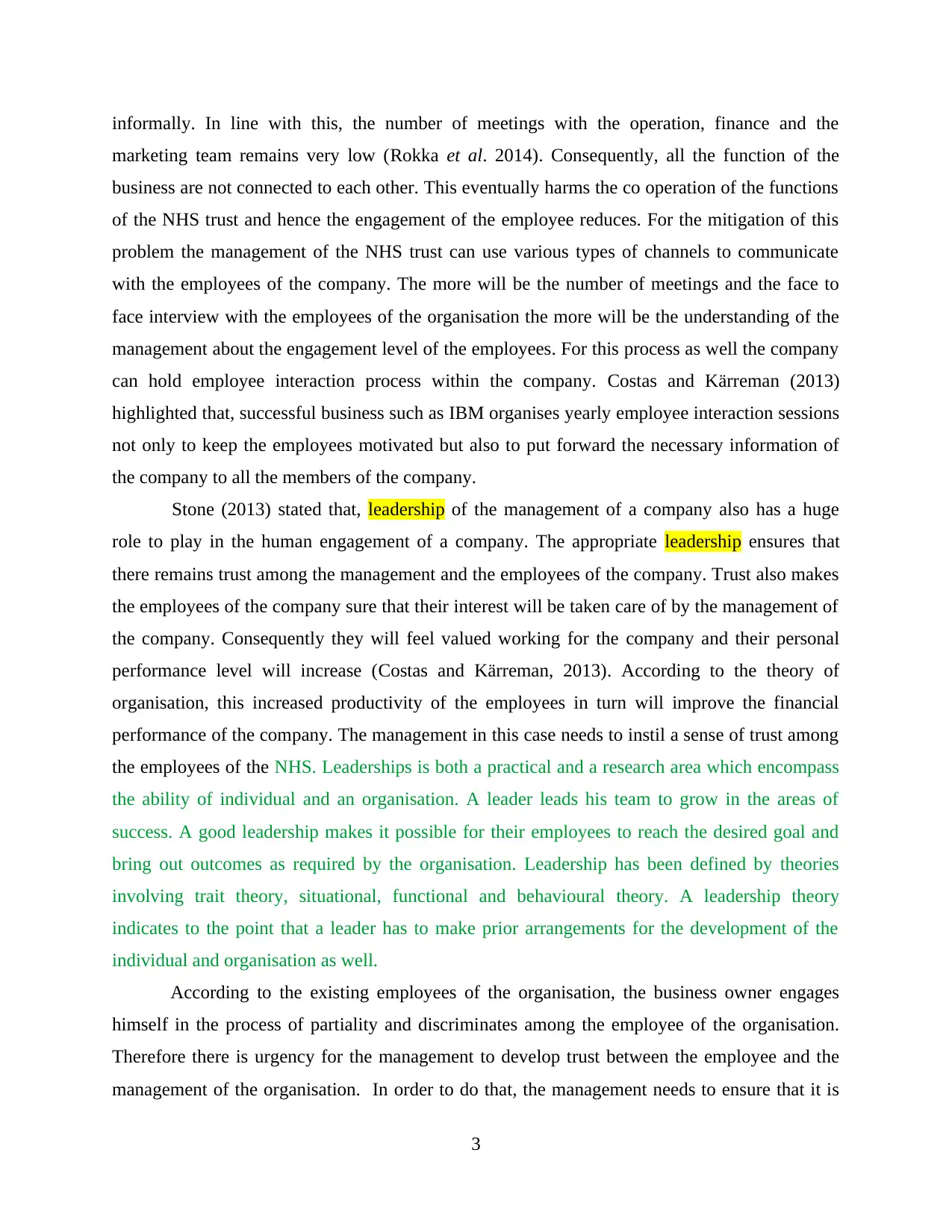
informally. In line with this, the number of meetings with the operation, finance and the
marketing team remains very low (Rokka et al. 2014). Consequently, all the function of the
business are not connected to each other. This eventually harms the co operation of the functions
of the NHS trust and hence the engagement of the employee reduces. For the mitigation of this
problem the management of the NHS trust can use various types of channels to communicate
with the employees of the company. The more will be the number of meetings and the face to
face interview with the employees of the organisation the more will be the understanding of the
management about the engagement level of the employees. For this process as well the company
can hold employee interaction process within the company. Costas and Kärreman (2013)
highlighted that, successful business such as IBM organises yearly employee interaction sessions
not only to keep the employees motivated but also to put forward the necessary information of
the company to all the members of the company.
Stone (2013) stated that, leadership of the management of a company also has a huge
role to play in the human engagement of a company. The appropriate leadership ensures that
there remains trust among the management and the employees of the company. Trust also makes
the employees of the company sure that their interest will be taken care of by the management of
the company. Consequently they will feel valued working for the company and their personal
performance level will increase (Costas and Kärreman, 2013). According to the theory of
organisation, this increased productivity of the employees in turn will improve the financial
performance of the company. The management in this case needs to instil a sense of trust among
the employees of the NHS. Leaderships is both a practical and a research area which encompass
the ability of individual and an organisation. A leader leads his team to grow in the areas of
success. A good leadership makes it possible for their employees to reach the desired goal and
bring out outcomes as required by the organisation. Leadership has been defined by theories
involving trait theory, situational, functional and behavioural theory. A leadership theory
indicates to the point that a leader has to make prior arrangements for the development of the
individual and organisation as well.
According to the existing employees of the organisation, the business owner engages
himself in the process of partiality and discriminates among the employee of the organisation.
Therefore there is urgency for the management to develop trust between the employee and the
management of the organisation. In order to do that, the management needs to ensure that it is
3
marketing team remains very low (Rokka et al. 2014). Consequently, all the function of the
business are not connected to each other. This eventually harms the co operation of the functions
of the NHS trust and hence the engagement of the employee reduces. For the mitigation of this
problem the management of the NHS trust can use various types of channels to communicate
with the employees of the company. The more will be the number of meetings and the face to
face interview with the employees of the organisation the more will be the understanding of the
management about the engagement level of the employees. For this process as well the company
can hold employee interaction process within the company. Costas and Kärreman (2013)
highlighted that, successful business such as IBM organises yearly employee interaction sessions
not only to keep the employees motivated but also to put forward the necessary information of
the company to all the members of the company.
Stone (2013) stated that, leadership of the management of a company also has a huge
role to play in the human engagement of a company. The appropriate leadership ensures that
there remains trust among the management and the employees of the company. Trust also makes
the employees of the company sure that their interest will be taken care of by the management of
the company. Consequently they will feel valued working for the company and their personal
performance level will increase (Costas and Kärreman, 2013). According to the theory of
organisation, this increased productivity of the employees in turn will improve the financial
performance of the company. The management in this case needs to instil a sense of trust among
the employees of the NHS. Leaderships is both a practical and a research area which encompass
the ability of individual and an organisation. A leader leads his team to grow in the areas of
success. A good leadership makes it possible for their employees to reach the desired goal and
bring out outcomes as required by the organisation. Leadership has been defined by theories
involving trait theory, situational, functional and behavioural theory. A leadership theory
indicates to the point that a leader has to make prior arrangements for the development of the
individual and organisation as well.
According to the existing employees of the organisation, the business owner engages
himself in the process of partiality and discriminates among the employee of the organisation.
Therefore there is urgency for the management to develop trust between the employee and the
management of the organisation. In order to do that, the management needs to ensure that it is
3
⊘ This is a preview!⊘
Do you want full access?
Subscribe today to unlock all pages.

Trusted by 1+ million students worldwide
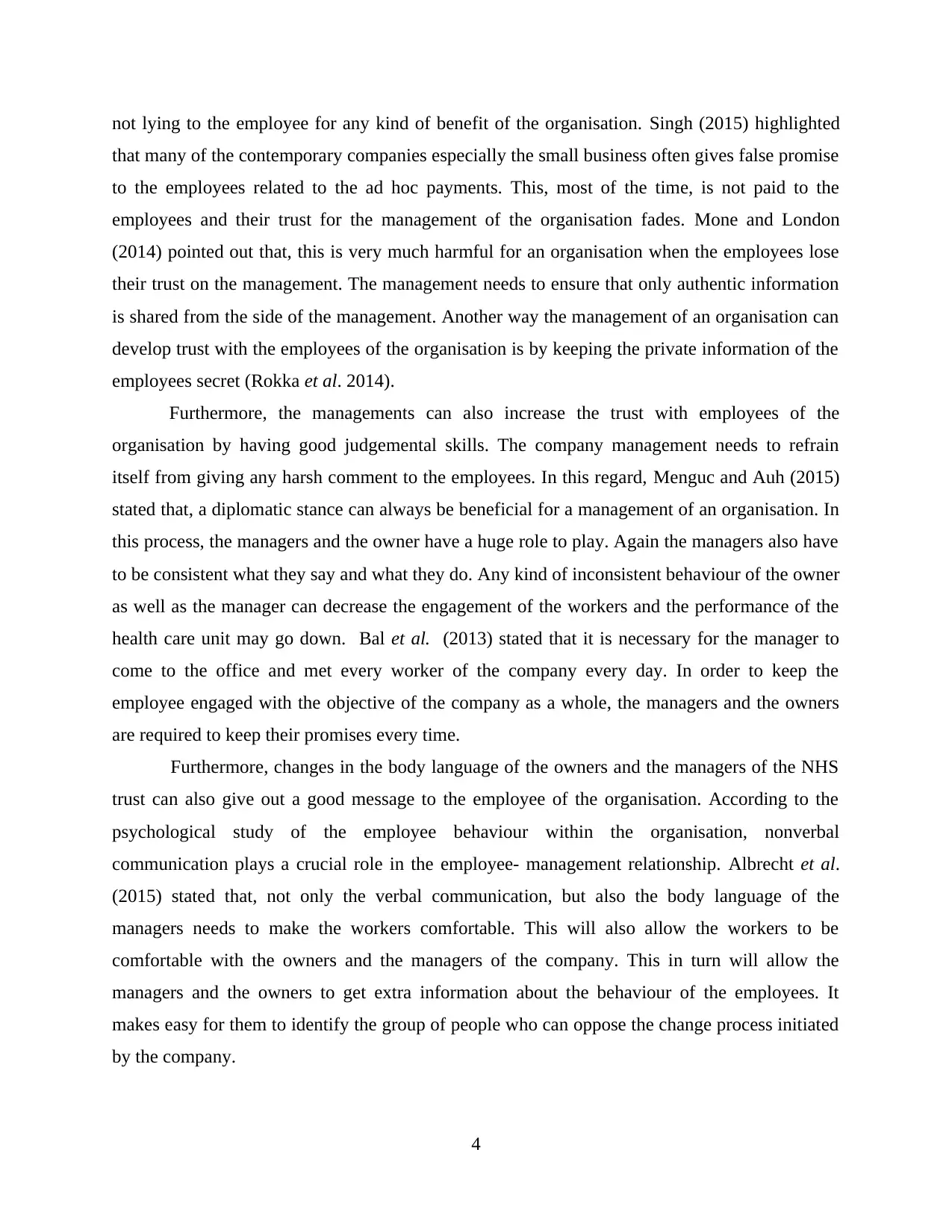
not lying to the employee for any kind of benefit of the organisation. Singh (2015) highlighted
that many of the contemporary companies especially the small business often gives false promise
to the employees related to the ad hoc payments. This, most of the time, is not paid to the
employees and their trust for the management of the organisation fades. Mone and London
(2014) pointed out that, this is very much harmful for an organisation when the employees lose
their trust on the management. The management needs to ensure that only authentic information
is shared from the side of the management. Another way the management of an organisation can
develop trust with the employees of the organisation is by keeping the private information of the
employees secret (Rokka et al. 2014).
Furthermore, the managements can also increase the trust with employees of the
organisation by having good judgemental skills. The company management needs to refrain
itself from giving any harsh comment to the employees. In this regard, Menguc and Auh (2015)
stated that, a diplomatic stance can always be beneficial for a management of an organisation. In
this process, the managers and the owner have a huge role to play. Again the managers also have
to be consistent what they say and what they do. Any kind of inconsistent behaviour of the owner
as well as the manager can decrease the engagement of the workers and the performance of the
health care unit may go down. Bal et al. (2013) stated that it is necessary for the manager to
come to the office and met every worker of the company every day. In order to keep the
employee engaged with the objective of the company as a whole, the managers and the owners
are required to keep their promises every time.
Furthermore, changes in the body language of the owners and the managers of the NHS
trust can also give out a good message to the employee of the organisation. According to the
psychological study of the employee behaviour within the organisation, nonverbal
communication plays a crucial role in the employee- management relationship. Albrecht et al.
(2015) stated that, not only the verbal communication, but also the body language of the
managers needs to make the workers comfortable. This will also allow the workers to be
comfortable with the owners and the managers of the company. This in turn will allow the
managers and the owners to get extra information about the behaviour of the employees. It
makes easy for them to identify the group of people who can oppose the change process initiated
by the company.
4
that many of the contemporary companies especially the small business often gives false promise
to the employees related to the ad hoc payments. This, most of the time, is not paid to the
employees and their trust for the management of the organisation fades. Mone and London
(2014) pointed out that, this is very much harmful for an organisation when the employees lose
their trust on the management. The management needs to ensure that only authentic information
is shared from the side of the management. Another way the management of an organisation can
develop trust with the employees of the organisation is by keeping the private information of the
employees secret (Rokka et al. 2014).
Furthermore, the managements can also increase the trust with employees of the
organisation by having good judgemental skills. The company management needs to refrain
itself from giving any harsh comment to the employees. In this regard, Menguc and Auh (2015)
stated that, a diplomatic stance can always be beneficial for a management of an organisation. In
this process, the managers and the owner have a huge role to play. Again the managers also have
to be consistent what they say and what they do. Any kind of inconsistent behaviour of the owner
as well as the manager can decrease the engagement of the workers and the performance of the
health care unit may go down. Bal et al. (2013) stated that it is necessary for the manager to
come to the office and met every worker of the company every day. In order to keep the
employee engaged with the objective of the company as a whole, the managers and the owners
are required to keep their promises every time.
Furthermore, changes in the body language of the owners and the managers of the NHS
trust can also give out a good message to the employee of the organisation. According to the
psychological study of the employee behaviour within the organisation, nonverbal
communication plays a crucial role in the employee- management relationship. Albrecht et al.
(2015) stated that, not only the verbal communication, but also the body language of the
managers needs to make the workers comfortable. This will also allow the workers to be
comfortable with the owners and the managers of the company. This in turn will allow the
managers and the owners to get extra information about the behaviour of the employees. It
makes easy for them to identify the group of people who can oppose the change process initiated
by the company.
4
Paraphrase This Document
Need a fresh take? Get an instant paraphrase of this document with our AI Paraphraser
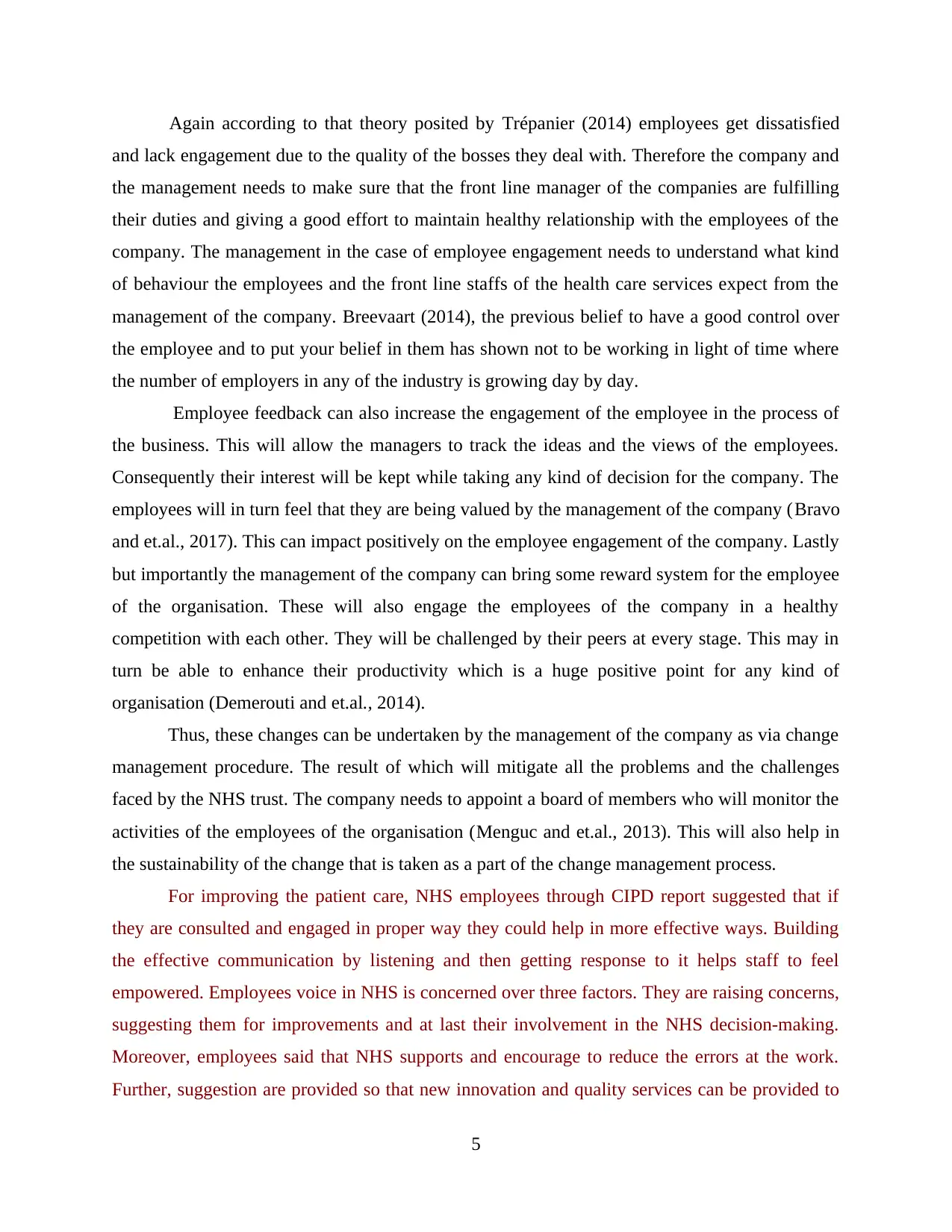
Again according to that theory posited by Trépanier (2014) employees get dissatisfied
and lack engagement due to the quality of the bosses they deal with. Therefore the company and
the management needs to make sure that the front line manager of the companies are fulfilling
their duties and giving a good effort to maintain healthy relationship with the employees of the
company. The management in the case of employee engagement needs to understand what kind
of behaviour the employees and the front line staffs of the health care services expect from the
management of the company. Breevaart (2014), the previous belief to have a good control over
the employee and to put your belief in them has shown not to be working in light of time where
the number of employers in any of the industry is growing day by day.
Employee feedback can also increase the engagement of the employee in the process of
the business. This will allow the managers to track the ideas and the views of the employees.
Consequently their interest will be kept while taking any kind of decision for the company. The
employees will in turn feel that they are being valued by the management of the company (Bravo
and et.al., 2017). This can impact positively on the employee engagement of the company. Lastly
but importantly the management of the company can bring some reward system for the employee
of the organisation. These will also engage the employees of the company in a healthy
competition with each other. They will be challenged by their peers at every stage. This may in
turn be able to enhance their productivity which is a huge positive point for any kind of
organisation (Demerouti and et.al., 2014).
Thus, these changes can be undertaken by the management of the company as via change
management procedure. The result of which will mitigate all the problems and the challenges
faced by the NHS trust. The company needs to appoint a board of members who will monitor the
activities of the employees of the organisation (Menguc and et.al., 2013). This will also help in
the sustainability of the change that is taken as a part of the change management process.
For improving the patient care, NHS employees through CIPD report suggested that if
they are consulted and engaged in proper way they could help in more effective ways. Building
the effective communication by listening and then getting response to it helps staff to feel
empowered. Employees voice in NHS is concerned over three factors. They are raising concerns,
suggesting them for improvements and at last their involvement in the NHS decision-making.
Moreover, employees said that NHS supports and encourage to reduce the errors at the work.
Further, suggestion are provided so that new innovation and quality services can be provided to
5
and lack engagement due to the quality of the bosses they deal with. Therefore the company and
the management needs to make sure that the front line manager of the companies are fulfilling
their duties and giving a good effort to maintain healthy relationship with the employees of the
company. The management in the case of employee engagement needs to understand what kind
of behaviour the employees and the front line staffs of the health care services expect from the
management of the company. Breevaart (2014), the previous belief to have a good control over
the employee and to put your belief in them has shown not to be working in light of time where
the number of employers in any of the industry is growing day by day.
Employee feedback can also increase the engagement of the employee in the process of
the business. This will allow the managers to track the ideas and the views of the employees.
Consequently their interest will be kept while taking any kind of decision for the company. The
employees will in turn feel that they are being valued by the management of the company (Bravo
and et.al., 2017). This can impact positively on the employee engagement of the company. Lastly
but importantly the management of the company can bring some reward system for the employee
of the organisation. These will also engage the employees of the company in a healthy
competition with each other. They will be challenged by their peers at every stage. This may in
turn be able to enhance their productivity which is a huge positive point for any kind of
organisation (Demerouti and et.al., 2014).
Thus, these changes can be undertaken by the management of the company as via change
management procedure. The result of which will mitigate all the problems and the challenges
faced by the NHS trust. The company needs to appoint a board of members who will monitor the
activities of the employees of the organisation (Menguc and et.al., 2013). This will also help in
the sustainability of the change that is taken as a part of the change management process.
For improving the patient care, NHS employees through CIPD report suggested that if
they are consulted and engaged in proper way they could help in more effective ways. Building
the effective communication by listening and then getting response to it helps staff to feel
empowered. Employees voice in NHS is concerned over three factors. They are raising concerns,
suggesting them for improvements and at last their involvement in the NHS decision-making.
Moreover, employees said that NHS supports and encourage to reduce the errors at the work.
Further, suggestion are provided so that new innovation and quality services can be provided to
5
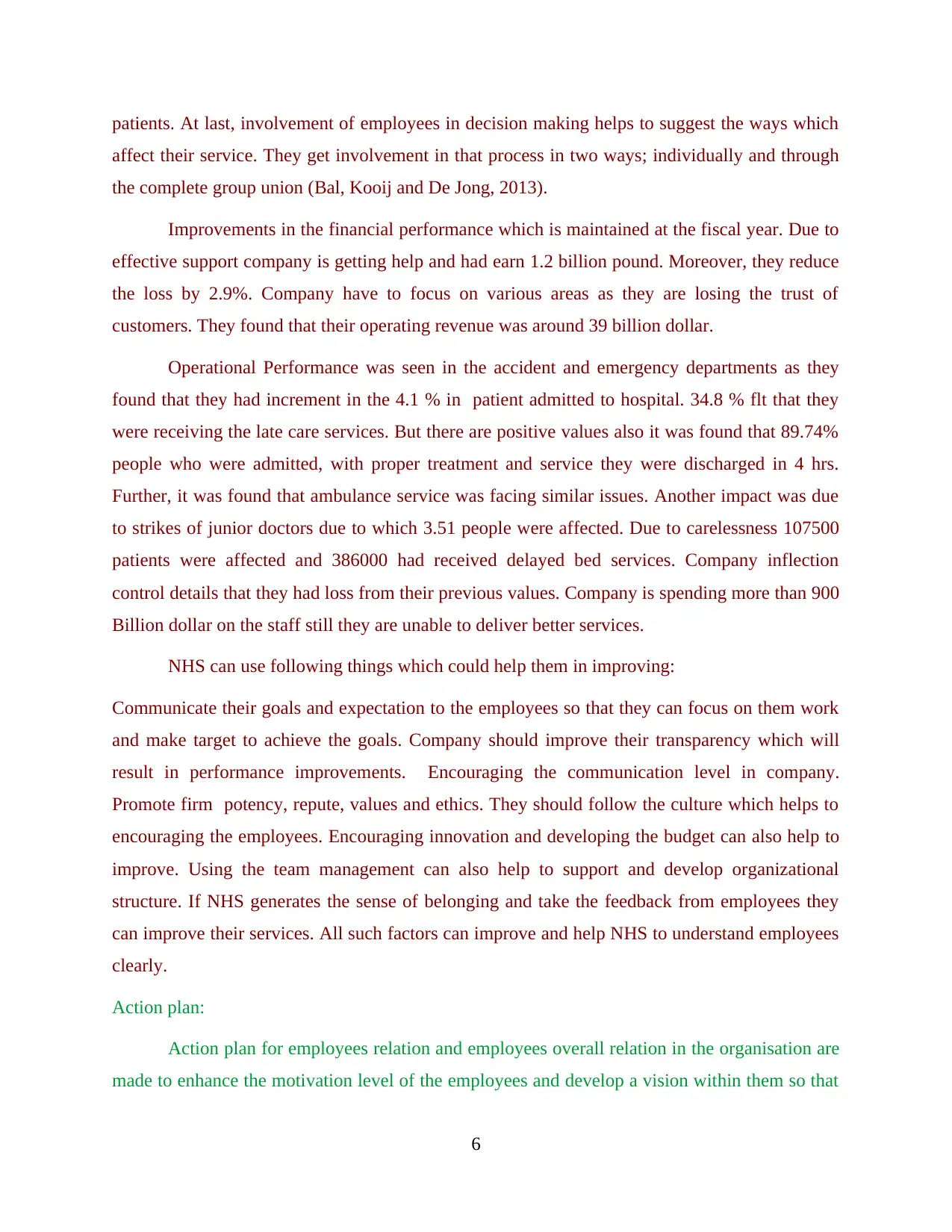
patients. At last, involvement of employees in decision making helps to suggest the ways which
affect their service. They get involvement in that process in two ways; individually and through
the complete group union (Bal, Kooij and De Jong, 2013).
Improvements in the financial performance which is maintained at the fiscal year. Due to
effective support company is getting help and had earn 1.2 billion pound. Moreover, they reduce
the loss by 2.9%. Company have to focus on various areas as they are losing the trust of
customers. They found that their operating revenue was around 39 billion dollar.
Operational Performance was seen in the accident and emergency departments as they
found that they had increment in the 4.1 % in patient admitted to hospital. 34.8 % flt that they
were receiving the late care services. But there are positive values also it was found that 89.74%
people who were admitted, with proper treatment and service they were discharged in 4 hrs.
Further, it was found that ambulance service was facing similar issues. Another impact was due
to strikes of junior doctors due to which 3.51 people were affected. Due to carelessness 107500
patients were affected and 386000 had received delayed bed services. Company inflection
control details that they had loss from their previous values. Company is spending more than 900
Billion dollar on the staff still they are unable to deliver better services.
NHS can use following things which could help them in improving:
Communicate their goals and expectation to the employees so that they can focus on them work
and make target to achieve the goals. Company should improve their transparency which will
result in performance improvements. Encouraging the communication level in company.
Promote firm potency, repute, values and ethics. They should follow the culture which helps to
encouraging the employees. Encouraging innovation and developing the budget can also help to
improve. Using the team management can also help to support and develop organizational
structure. If NHS generates the sense of belonging and take the feedback from employees they
can improve their services. All such factors can improve and help NHS to understand employees
clearly.
Action plan:
Action plan for employees relation and employees overall relation in the organisation are
made to enhance the motivation level of the employees and develop a vision within them so that
6
affect their service. They get involvement in that process in two ways; individually and through
the complete group union (Bal, Kooij and De Jong, 2013).
Improvements in the financial performance which is maintained at the fiscal year. Due to
effective support company is getting help and had earn 1.2 billion pound. Moreover, they reduce
the loss by 2.9%. Company have to focus on various areas as they are losing the trust of
customers. They found that their operating revenue was around 39 billion dollar.
Operational Performance was seen in the accident and emergency departments as they
found that they had increment in the 4.1 % in patient admitted to hospital. 34.8 % flt that they
were receiving the late care services. But there are positive values also it was found that 89.74%
people who were admitted, with proper treatment and service they were discharged in 4 hrs.
Further, it was found that ambulance service was facing similar issues. Another impact was due
to strikes of junior doctors due to which 3.51 people were affected. Due to carelessness 107500
patients were affected and 386000 had received delayed bed services. Company inflection
control details that they had loss from their previous values. Company is spending more than 900
Billion dollar on the staff still they are unable to deliver better services.
NHS can use following things which could help them in improving:
Communicate their goals and expectation to the employees so that they can focus on them work
and make target to achieve the goals. Company should improve their transparency which will
result in performance improvements. Encouraging the communication level in company.
Promote firm potency, repute, values and ethics. They should follow the culture which helps to
encouraging the employees. Encouraging innovation and developing the budget can also help to
improve. Using the team management can also help to support and develop organizational
structure. If NHS generates the sense of belonging and take the feedback from employees they
can improve their services. All such factors can improve and help NHS to understand employees
clearly.
Action plan:
Action plan for employees relation and employees overall relation in the organisation are
made to enhance the motivation level of the employees and develop a vision within them so that
6
⊘ This is a preview!⊘
Do you want full access?
Subscribe today to unlock all pages.

Trusted by 1+ million students worldwide
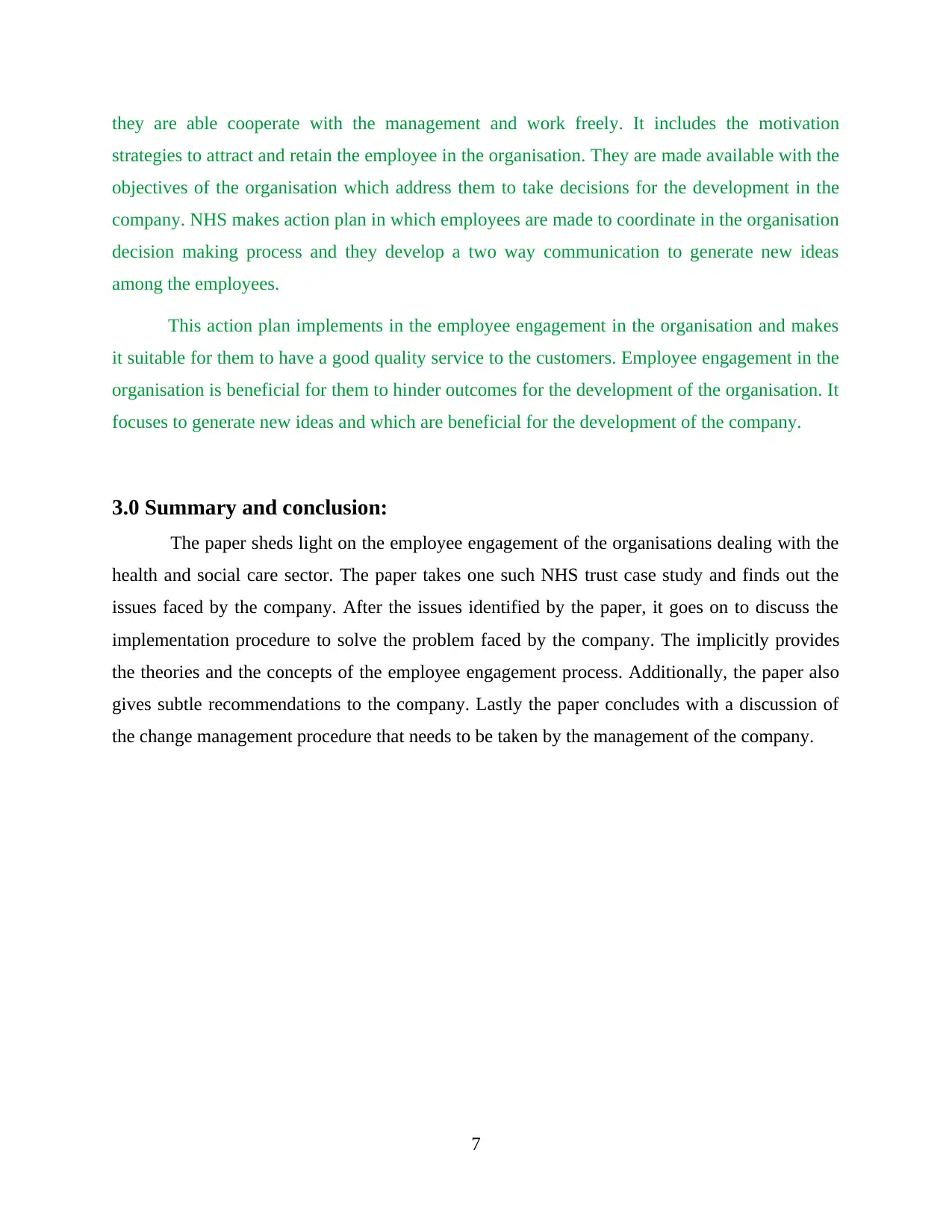
they are able cooperate with the management and work freely. It includes the motivation
strategies to attract and retain the employee in the organisation. They are made available with the
objectives of the organisation which address them to take decisions for the development in the
company. NHS makes action plan in which employees are made to coordinate in the organisation
decision making process and they develop a two way communication to generate new ideas
among the employees.
This action plan implements in the employee engagement in the organisation and makes
it suitable for them to have a good quality service to the customers. Employee engagement in the
organisation is beneficial for them to hinder outcomes for the development of the organisation. It
focuses to generate new ideas and which are beneficial for the development of the company.
3.0 Summary and conclusion:
The paper sheds light on the employee engagement of the organisations dealing with the
health and social care sector. The paper takes one such NHS trust case study and finds out the
issues faced by the company. After the issues identified by the paper, it goes on to discuss the
implementation procedure to solve the problem faced by the company. The implicitly provides
the theories and the concepts of the employee engagement process. Additionally, the paper also
gives subtle recommendations to the company. Lastly the paper concludes with a discussion of
the change management procedure that needs to be taken by the management of the company.
7
strategies to attract and retain the employee in the organisation. They are made available with the
objectives of the organisation which address them to take decisions for the development in the
company. NHS makes action plan in which employees are made to coordinate in the organisation
decision making process and they develop a two way communication to generate new ideas
among the employees.
This action plan implements in the employee engagement in the organisation and makes
it suitable for them to have a good quality service to the customers. Employee engagement in the
organisation is beneficial for them to hinder outcomes for the development of the organisation. It
focuses to generate new ideas and which are beneficial for the development of the company.
3.0 Summary and conclusion:
The paper sheds light on the employee engagement of the organisations dealing with the
health and social care sector. The paper takes one such NHS trust case study and finds out the
issues faced by the company. After the issues identified by the paper, it goes on to discuss the
implementation procedure to solve the problem faced by the company. The implicitly provides
the theories and the concepts of the employee engagement process. Additionally, the paper also
gives subtle recommendations to the company. Lastly the paper concludes with a discussion of
the change management procedure that needs to be taken by the management of the company.
7
Paraphrase This Document
Need a fresh take? Get an instant paraphrase of this document with our AI Paraphraser
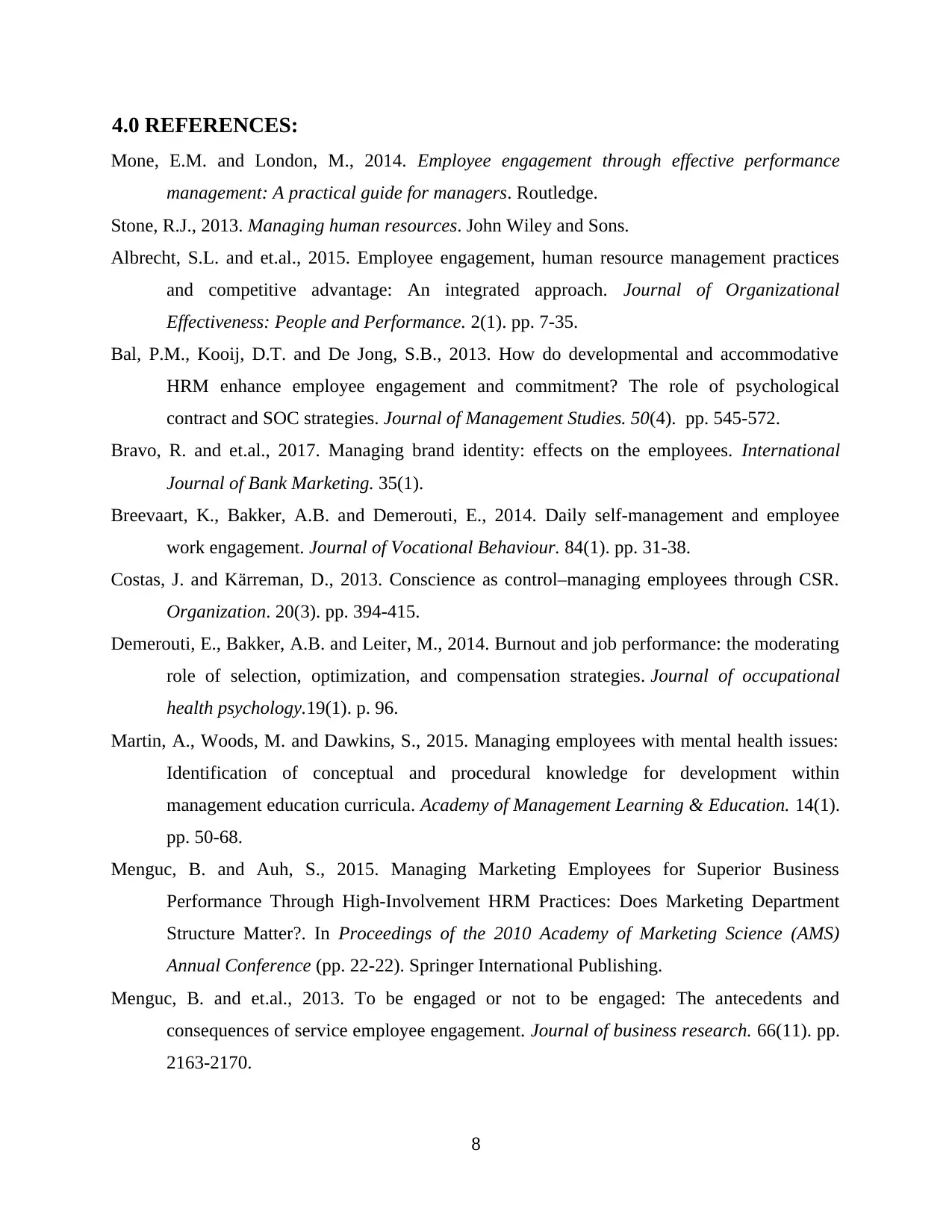
4.0 REFERENCES:
Mone, E.M. and London, M., 2014. Employee engagement through effective performance
management: A practical guide for managers. Routledge.
Stone, R.J., 2013. Managing human resources. John Wiley and Sons.
Albrecht, S.L. and et.al., 2015. Employee engagement, human resource management practices
and competitive advantage: An integrated approach. Journal of Organizational
Effectiveness: People and Performance. 2(1). pp. 7-35.
Bal, P.M., Kooij, D.T. and De Jong, S.B., 2013. How do developmental and accommodative
HRM enhance employee engagement and commitment? The role of psychological
contract and SOC strategies. Journal of Management Studies. 50(4). pp. 545-572.
Bravo, R. and et.al., 2017. Managing brand identity: effects on the employees. International
Journal of Bank Marketing. 35(1).
Breevaart, K., Bakker, A.B. and Demerouti, E., 2014. Daily self-management and employee
work engagement. Journal of Vocational Behaviour. 84(1). pp. 31-38.
Costas, J. and Kärreman, D., 2013. Conscience as control–managing employees through CSR.
Organization. 20(3). pp. 394-415.
Demerouti, E., Bakker, A.B. and Leiter, M., 2014. Burnout and job performance: the moderating
role of selection, optimization, and compensation strategies. Journal of occupational
health psychology.19(1). p. 96.
Martin, A., Woods, M. and Dawkins, S., 2015. Managing employees with mental health issues:
Identification of conceptual and procedural knowledge for development within
management education curricula. Academy of Management Learning & Education. 14(1).
pp. 50-68.
Menguc, B. and Auh, S., 2015. Managing Marketing Employees for Superior Business
Performance Through High-Involvement HRM Practices: Does Marketing Department
Structure Matter?. In Proceedings of the 2010 Academy of Marketing Science (AMS)
Annual Conference (pp. 22-22). Springer International Publishing.
Menguc, B. and et.al., 2013. To be engaged or not to be engaged: The antecedents and
consequences of service employee engagement. Journal of business research. 66(11). pp.
2163-2170.
8
Mone, E.M. and London, M., 2014. Employee engagement through effective performance
management: A practical guide for managers. Routledge.
Stone, R.J., 2013. Managing human resources. John Wiley and Sons.
Albrecht, S.L. and et.al., 2015. Employee engagement, human resource management practices
and competitive advantage: An integrated approach. Journal of Organizational
Effectiveness: People and Performance. 2(1). pp. 7-35.
Bal, P.M., Kooij, D.T. and De Jong, S.B., 2013. How do developmental and accommodative
HRM enhance employee engagement and commitment? The role of psychological
contract and SOC strategies. Journal of Management Studies. 50(4). pp. 545-572.
Bravo, R. and et.al., 2017. Managing brand identity: effects on the employees. International
Journal of Bank Marketing. 35(1).
Breevaart, K., Bakker, A.B. and Demerouti, E., 2014. Daily self-management and employee
work engagement. Journal of Vocational Behaviour. 84(1). pp. 31-38.
Costas, J. and Kärreman, D., 2013. Conscience as control–managing employees through CSR.
Organization. 20(3). pp. 394-415.
Demerouti, E., Bakker, A.B. and Leiter, M., 2014. Burnout and job performance: the moderating
role of selection, optimization, and compensation strategies. Journal of occupational
health psychology.19(1). p. 96.
Martin, A., Woods, M. and Dawkins, S., 2015. Managing employees with mental health issues:
Identification of conceptual and procedural knowledge for development within
management education curricula. Academy of Management Learning & Education. 14(1).
pp. 50-68.
Menguc, B. and Auh, S., 2015. Managing Marketing Employees for Superior Business
Performance Through High-Involvement HRM Practices: Does Marketing Department
Structure Matter?. In Proceedings of the 2010 Academy of Marketing Science (AMS)
Annual Conference (pp. 22-22). Springer International Publishing.
Menguc, B. and et.al., 2013. To be engaged or not to be engaged: The antecedents and
consequences of service employee engagement. Journal of business research. 66(11). pp.
2163-2170.
8
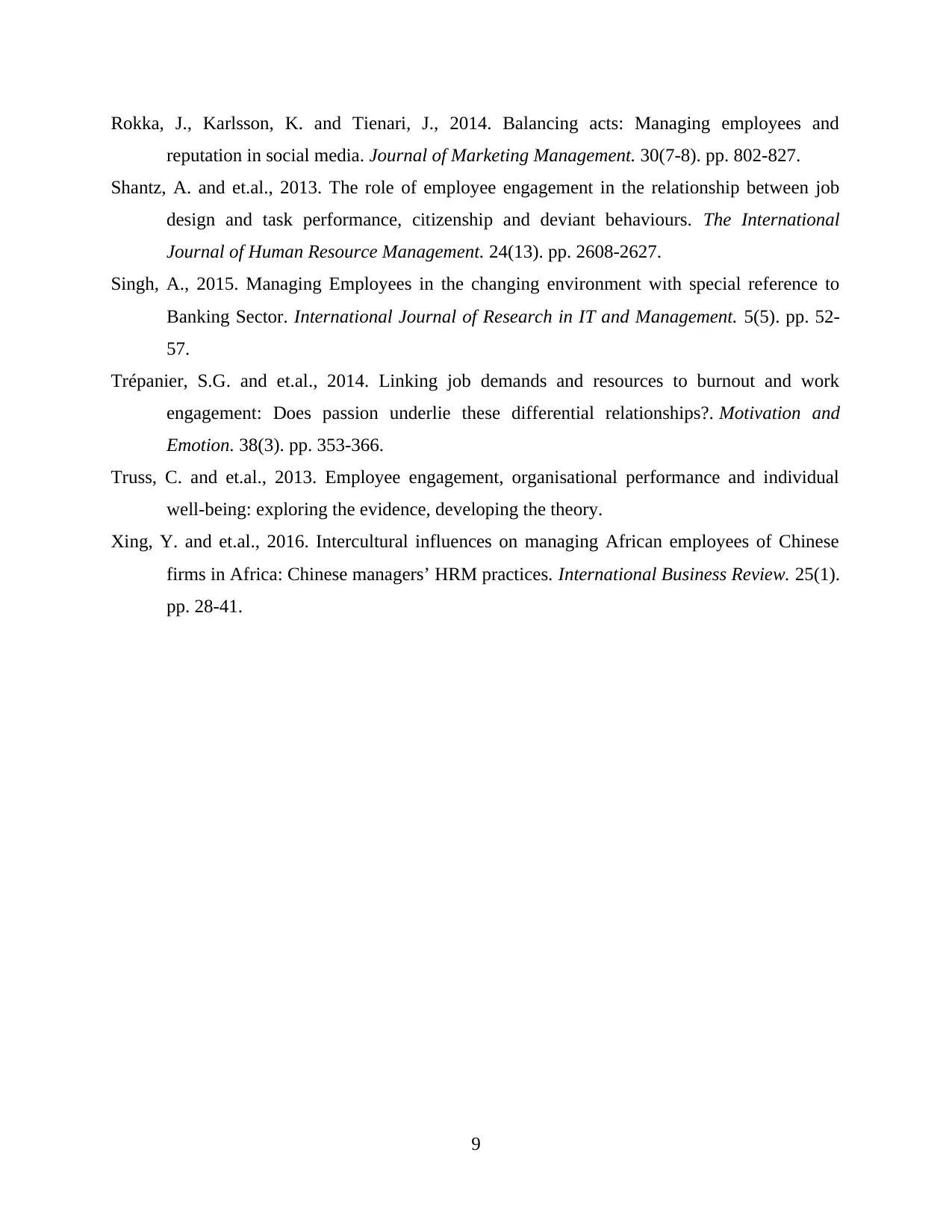
Rokka, J., Karlsson, K. and Tienari, J., 2014. Balancing acts: Managing employees and
reputation in social media. Journal of Marketing Management. 30(7-8). pp. 802-827.
Shantz, A. and et.al., 2013. The role of employee engagement in the relationship between job
design and task performance, citizenship and deviant behaviours. The International
Journal of Human Resource Management. 24(13). pp. 2608-2627.
Singh, A., 2015. Managing Employees in the changing environment with special reference to
Banking Sector. International Journal of Research in IT and Management. 5(5). pp. 52-
57.
Trépanier, S.G. and et.al., 2014. Linking job demands and resources to burnout and work
engagement: Does passion underlie these differential relationships?. Motivation and
Emotion. 38(3). pp. 353-366.
Truss, C. and et.al., 2013. Employee engagement, organisational performance and individual
well-being: exploring the evidence, developing the theory.
Xing, Y. and et.al., 2016. Intercultural influences on managing African employees of Chinese
firms in Africa: Chinese managers’ HRM practices. International Business Review. 25(1).
pp. 28-41.
9
reputation in social media. Journal of Marketing Management. 30(7-8). pp. 802-827.
Shantz, A. and et.al., 2013. The role of employee engagement in the relationship between job
design and task performance, citizenship and deviant behaviours. The International
Journal of Human Resource Management. 24(13). pp. 2608-2627.
Singh, A., 2015. Managing Employees in the changing environment with special reference to
Banking Sector. International Journal of Research in IT and Management. 5(5). pp. 52-
57.
Trépanier, S.G. and et.al., 2014. Linking job demands and resources to burnout and work
engagement: Does passion underlie these differential relationships?. Motivation and
Emotion. 38(3). pp. 353-366.
Truss, C. and et.al., 2013. Employee engagement, organisational performance and individual
well-being: exploring the evidence, developing the theory.
Xing, Y. and et.al., 2016. Intercultural influences on managing African employees of Chinese
firms in Africa: Chinese managers’ HRM practices. International Business Review. 25(1).
pp. 28-41.
9
⊘ This is a preview!⊘
Do you want full access?
Subscribe today to unlock all pages.

Trusted by 1+ million students worldwide
1 out of 14
Related Documents
Your All-in-One AI-Powered Toolkit for Academic Success.
+13062052269
info@desklib.com
Available 24*7 on WhatsApp / Email
![[object Object]](/_next/static/media/star-bottom.7253800d.svg)
Unlock your academic potential
Copyright © 2020–2025 A2Z Services. All Rights Reserved. Developed and managed by ZUCOL.





